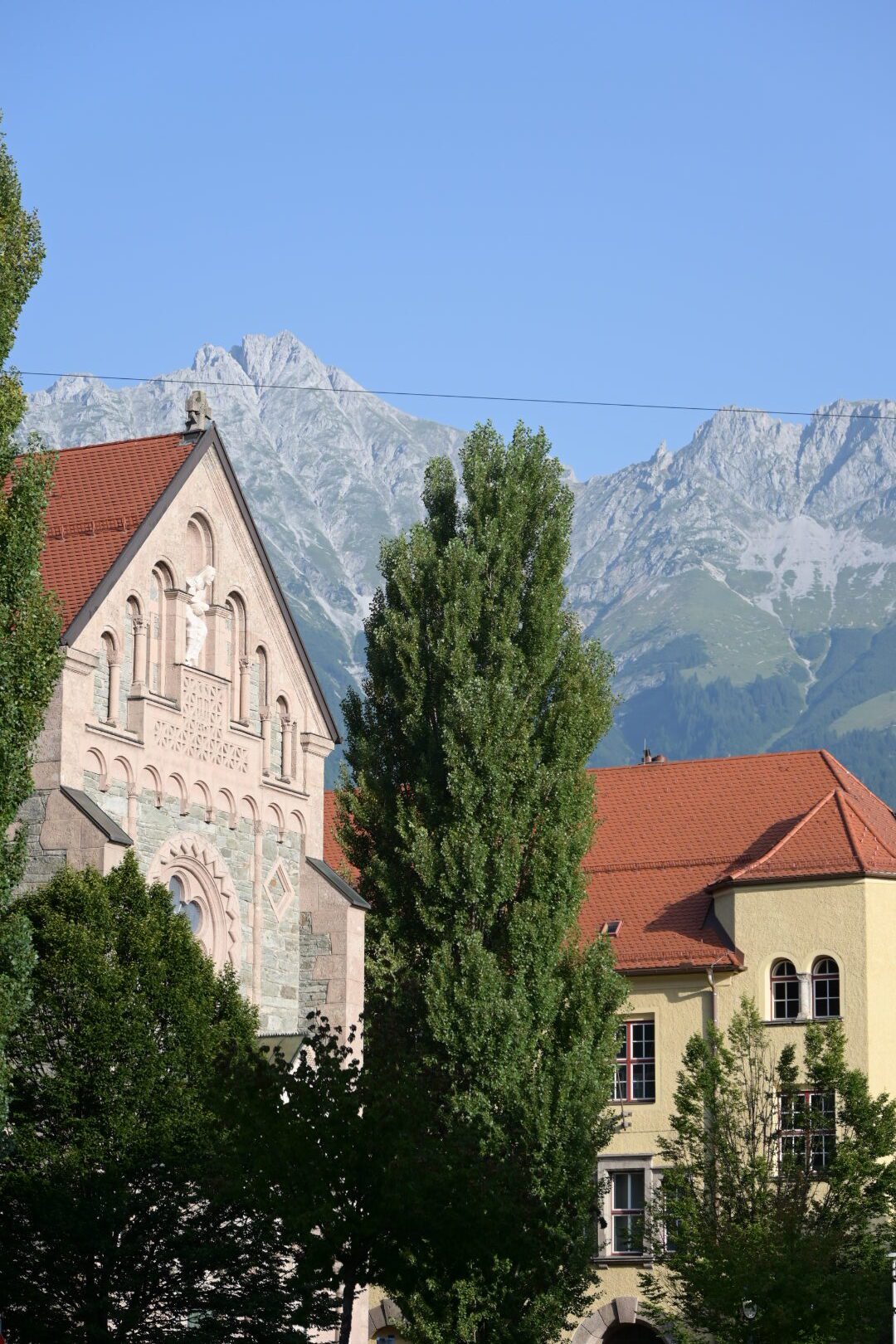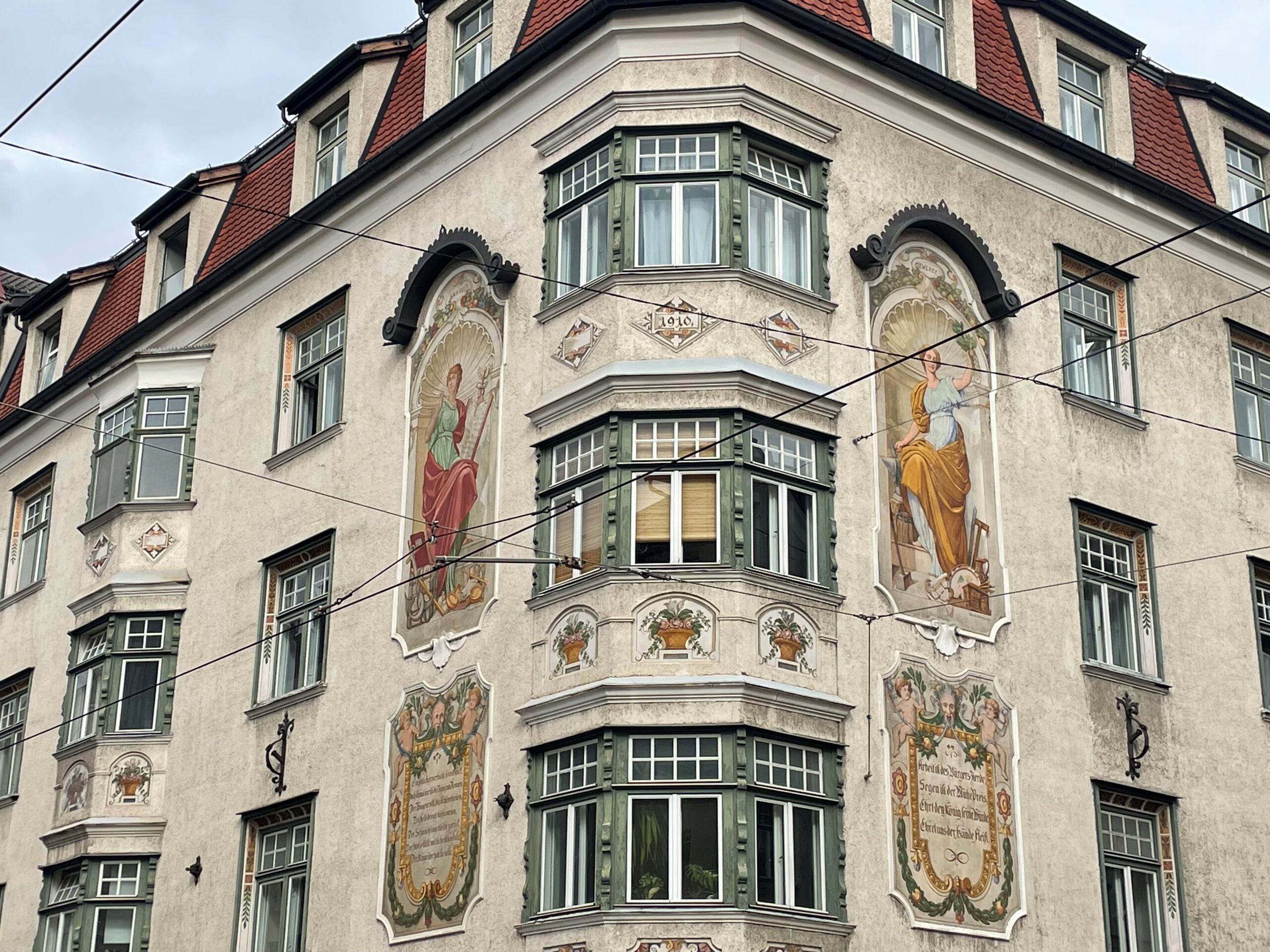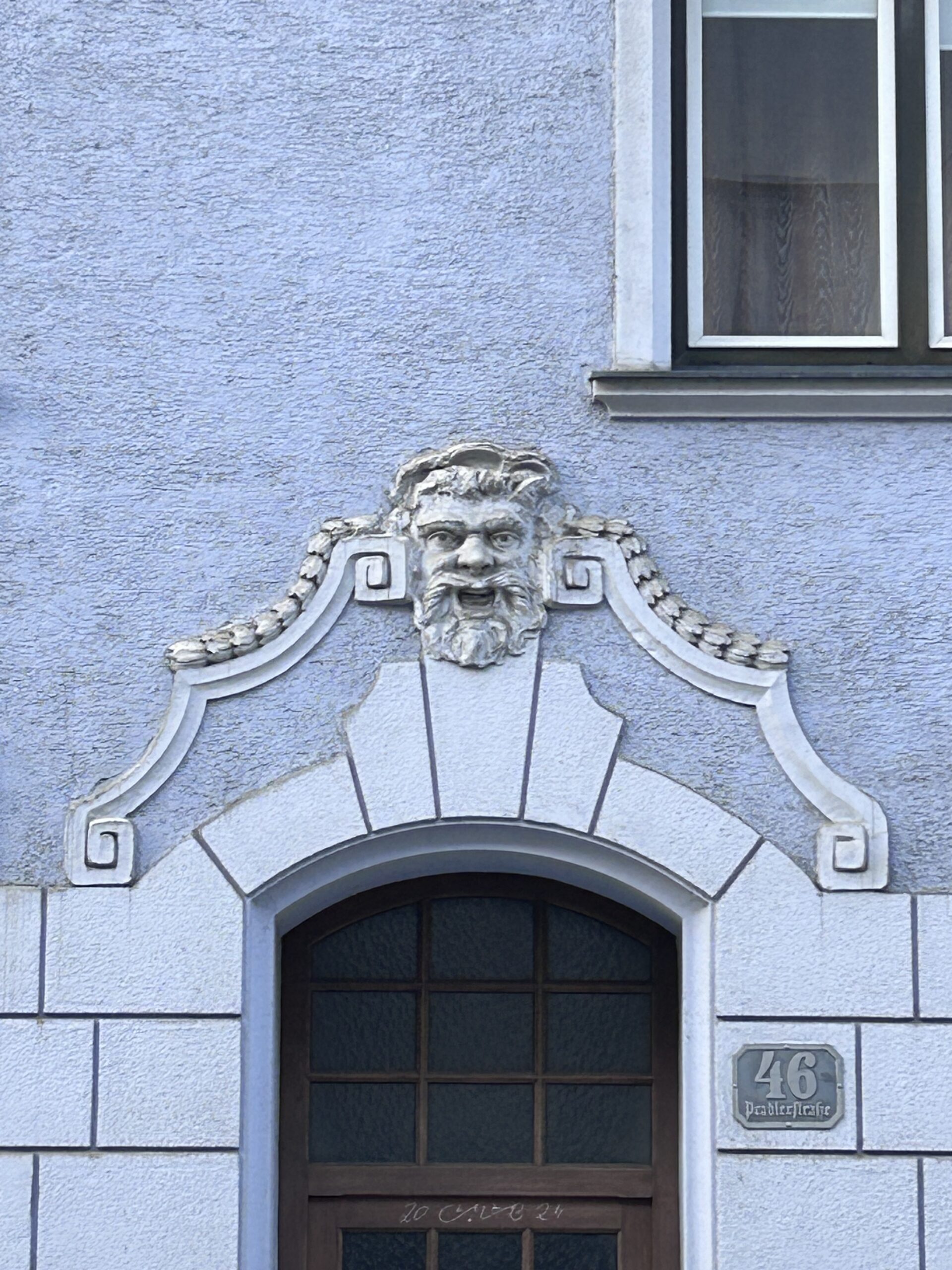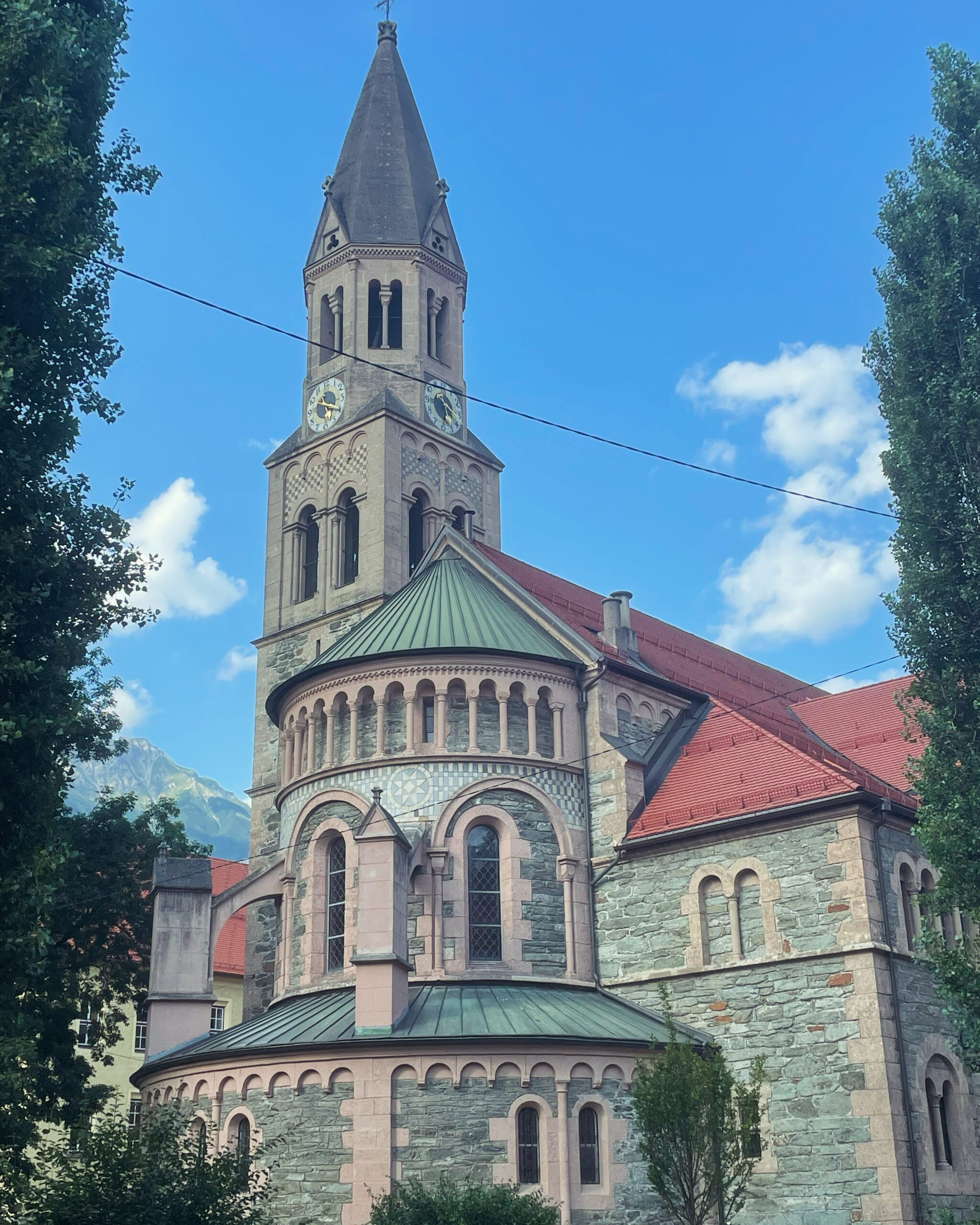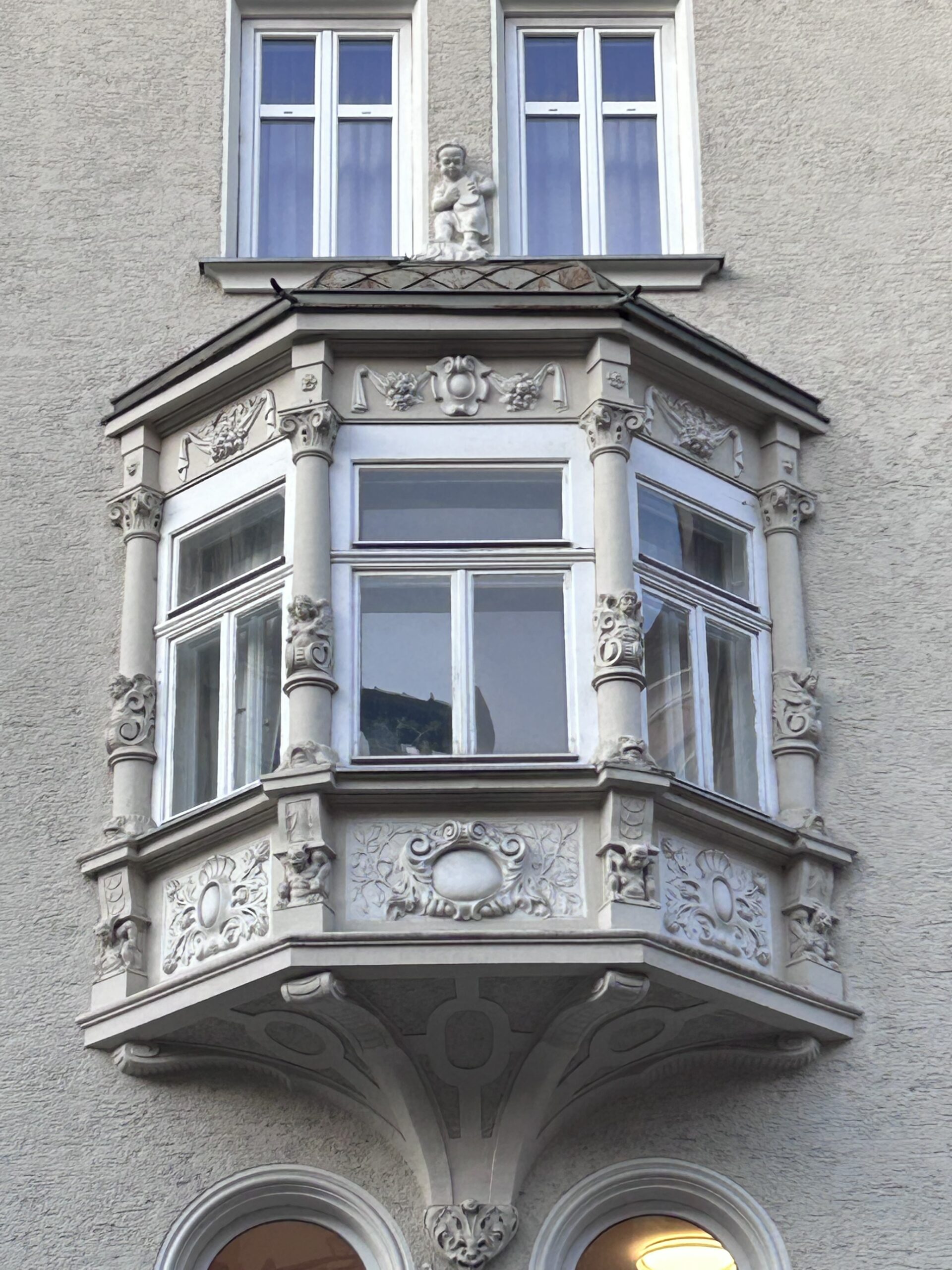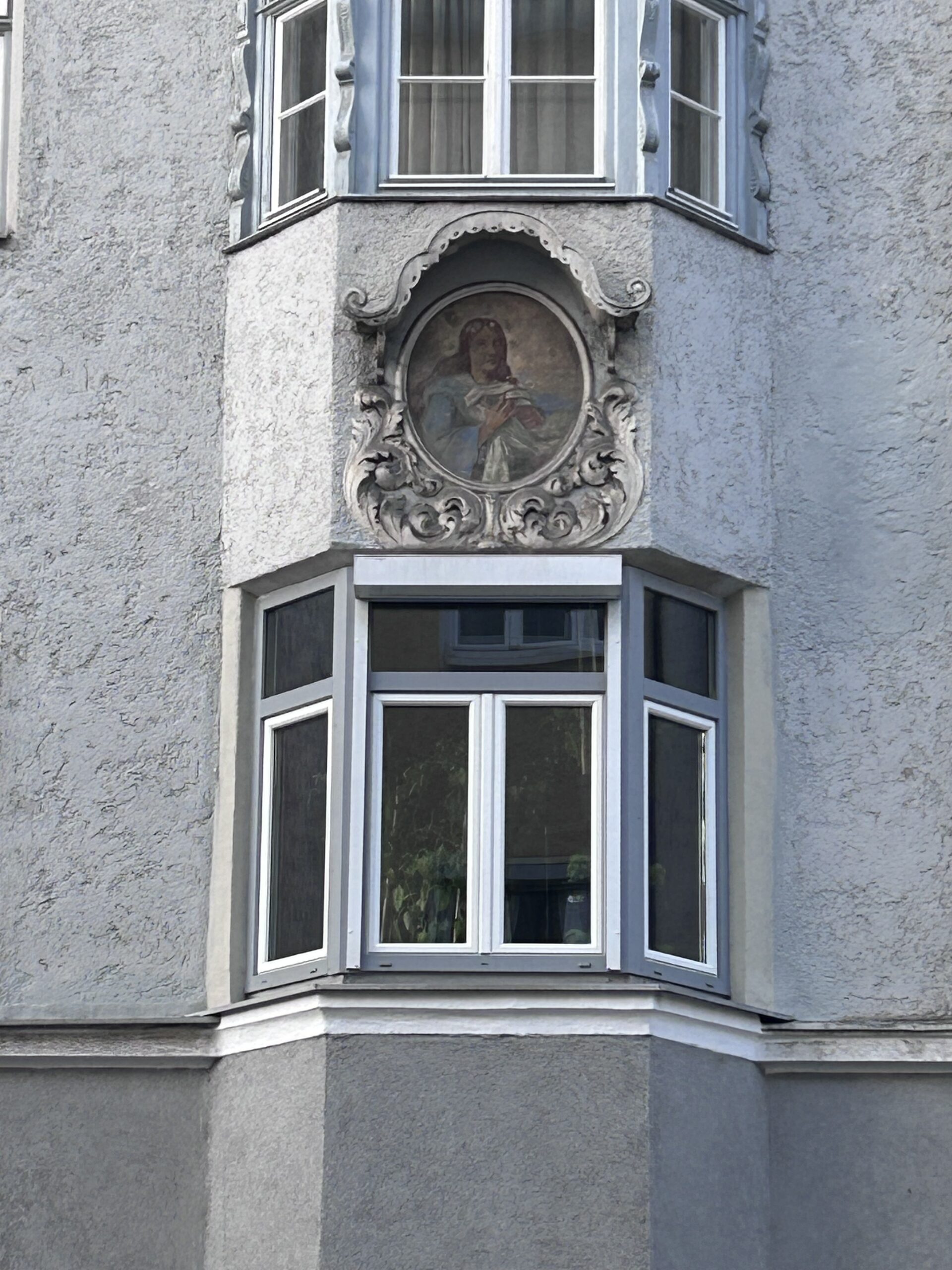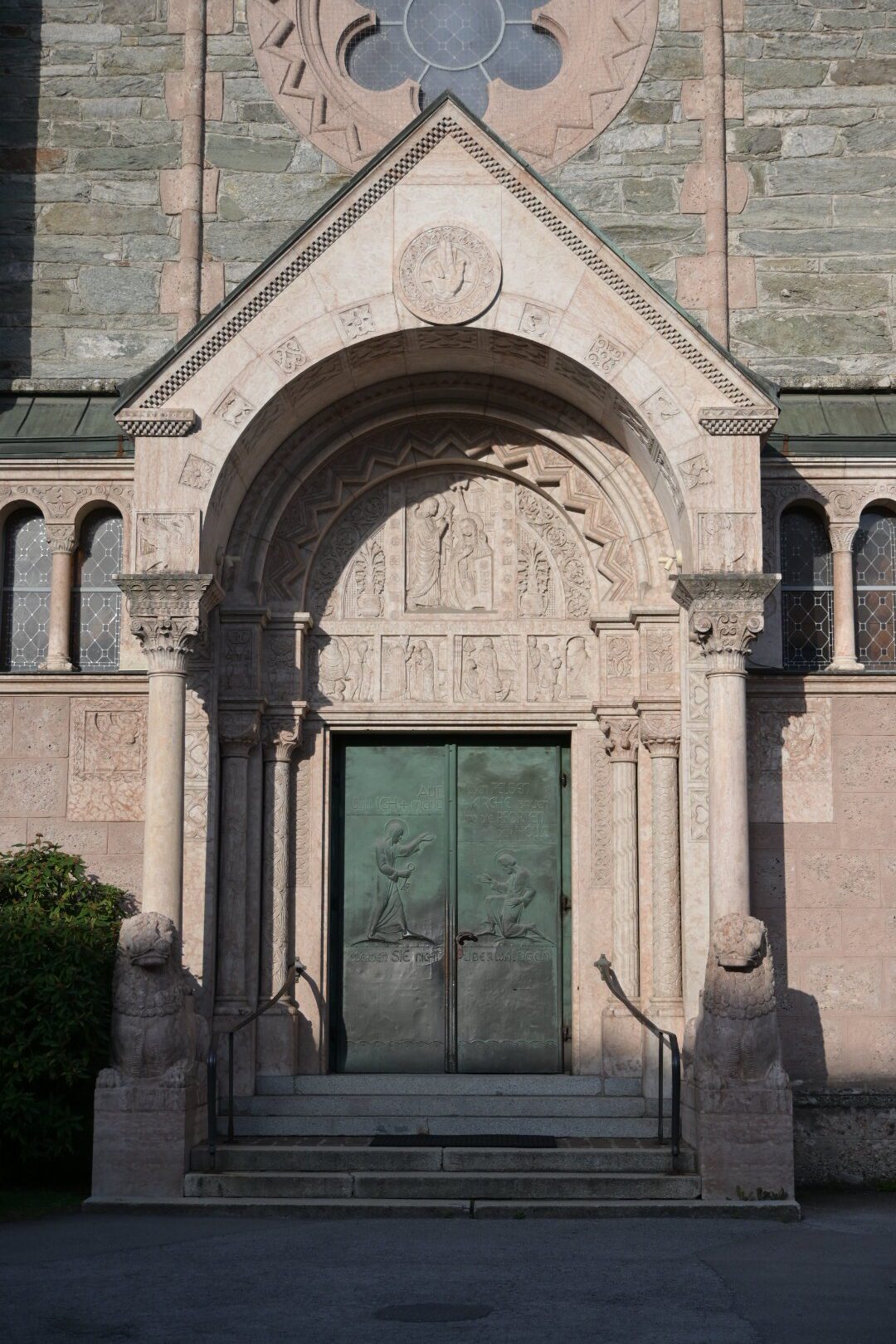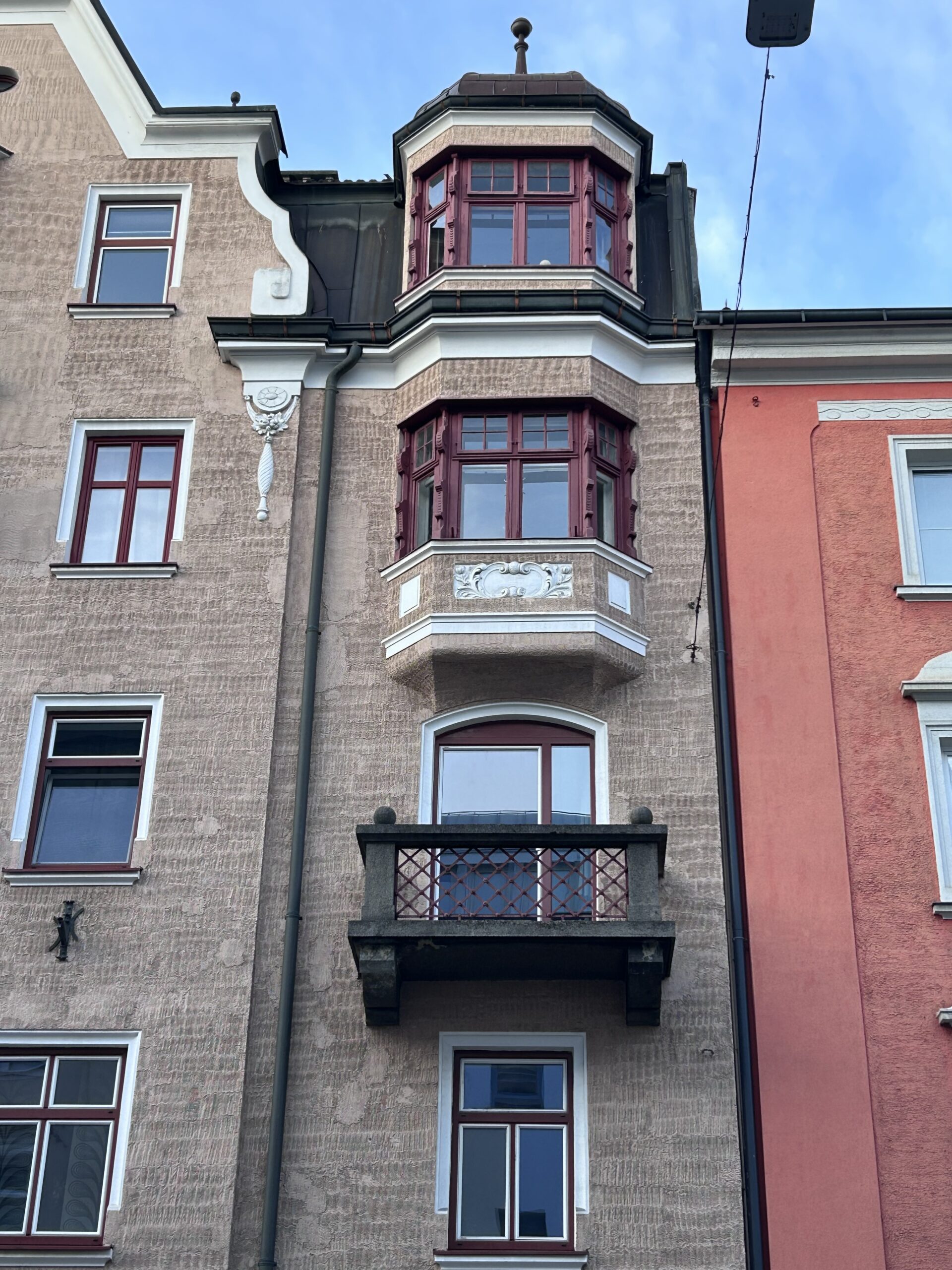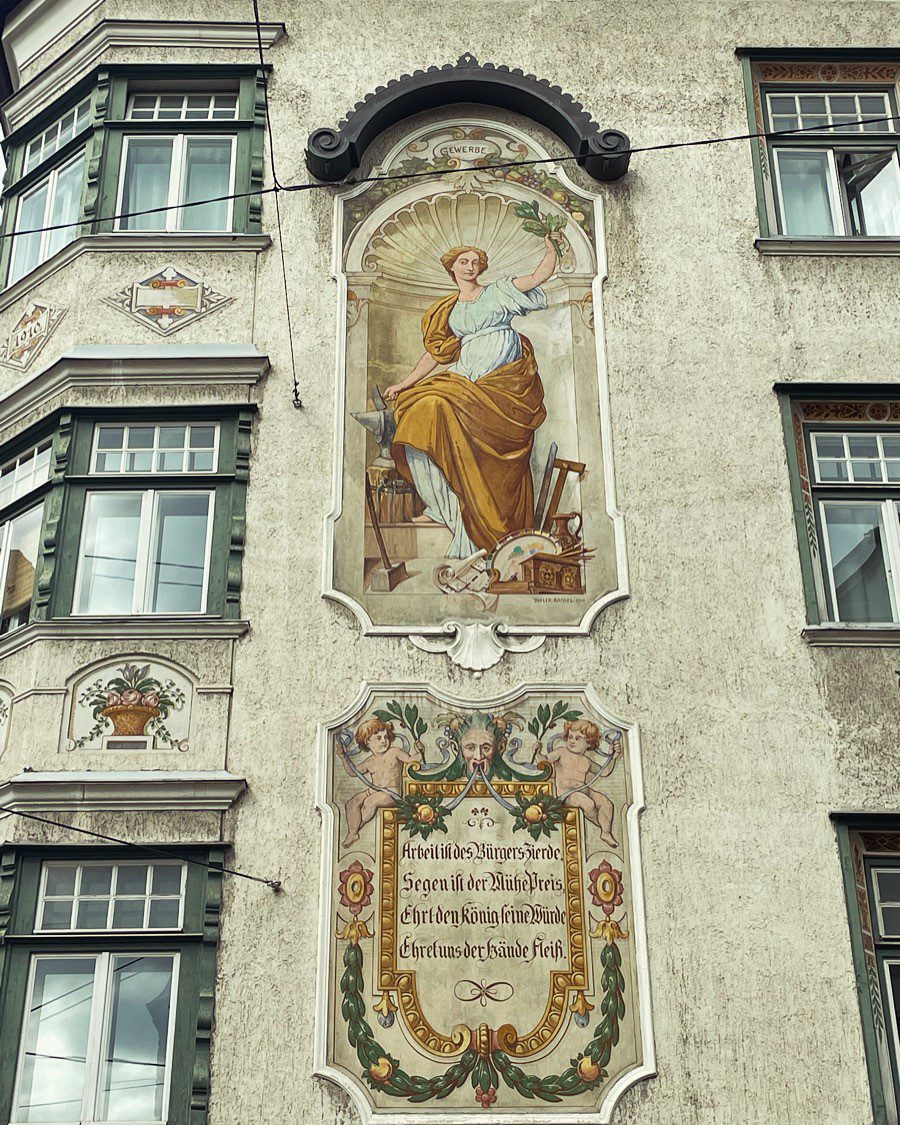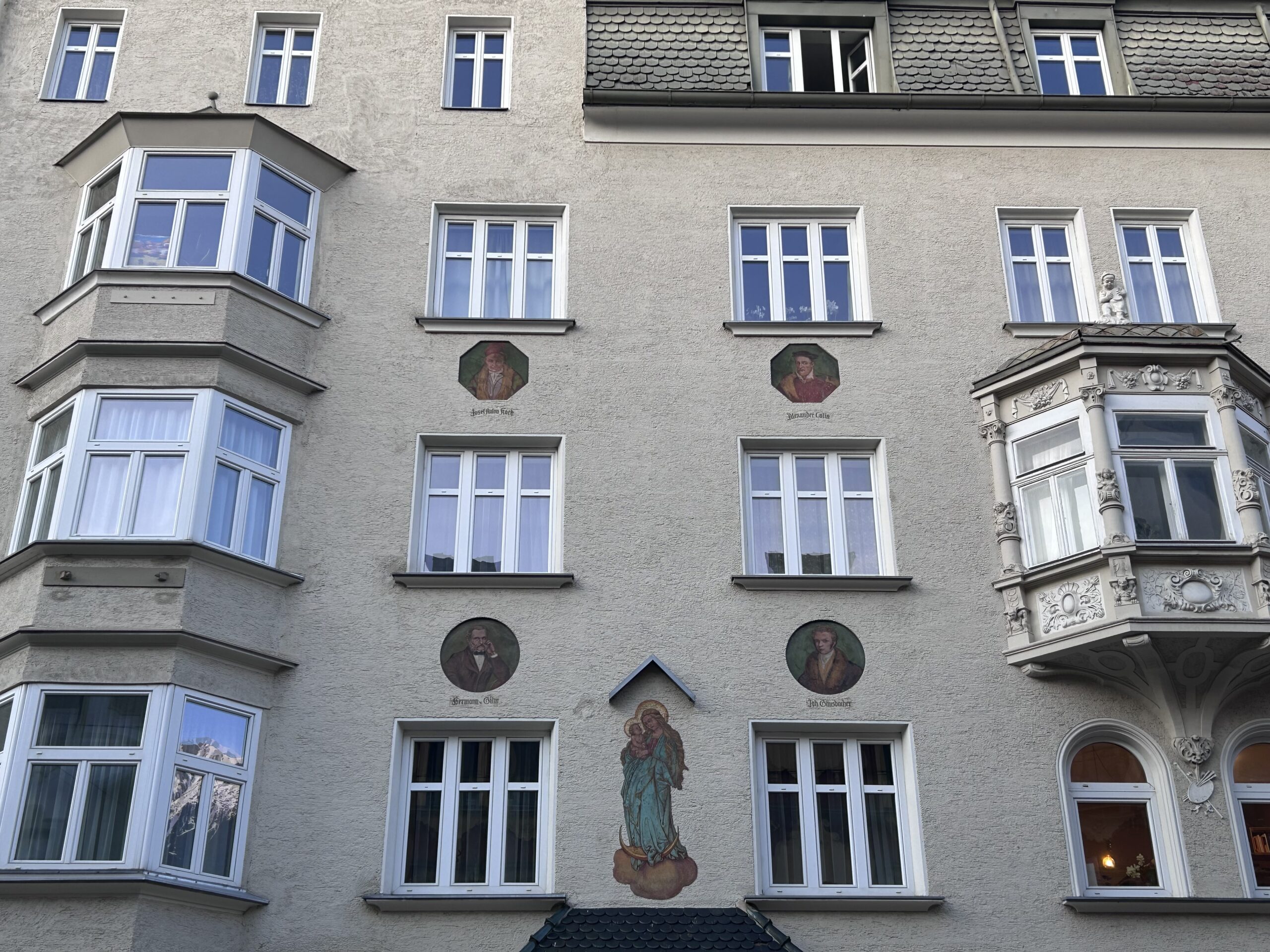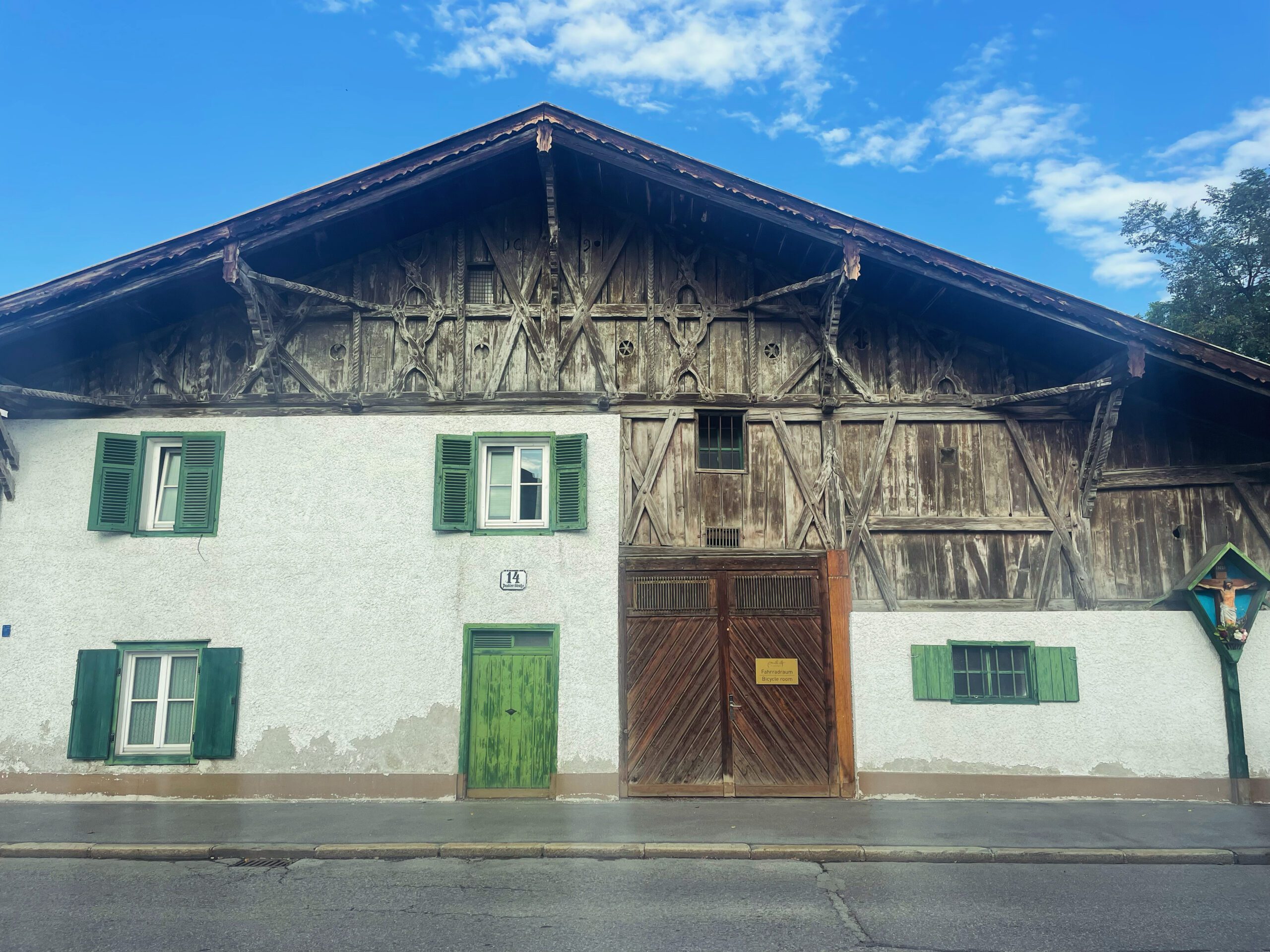Pradlerstraße
Pradlerstraße
Worth knowing
As early as the early modern period, there was a bridge over the Sill connecting Pradl and Innsbruck. This was the starting point of the fortified Fürstenwegwhich led all the way to Ambras Castle. The northern part of this early north-south connection is today's Pradlerstraße. A look at the development of this small area tells the story of Innsbruck's development between the 16th and 20th centuries.
Throughout the Middle Ages and early modern times, Pradl was one of many small, rural villages. Where the Leitgebhalle stands today, there was already a small chapel in the late 17th century. This place of worship was home to a copy of Lukas Cranach's Gnadenbild Mariahilf. The house at Pradlerstraße 9 on the corner of Reichenauerstraße has a copy of the popular depiction of St Mary on its northern façade. This house was also the birthplace of the writer Rudolf Greinz (1866 - 1942), whose Tyrolean local history novels were so popular with readers that a street was named after him in Pradl during his lifetime.
In the 19th century, Pradl, like the other peripheral areas, became an industrial centre. Boomtown. The farmhouses were gradually surrounded by modern apartment blocks and housing estates as the town expanded. Even before Pradl merged with Innsbruck in 1904, large employers such as the Rhomberg silk spinning mill and the gas works had already settled here. Bakeries, butchers, small shops and restaurants opened. New houses and flats were needed for the employees and workers. Between the junctions of Amthorstraße/Pradlerstraße and Gumppstraße/Pradlerstraße and in Gabelsbergerstraße, several of these residential and tenement buildings can still be found today. Unlike Wilten, which has always had a certain degree of industrialisation along the Sill Canal, Pradl was exclusively agricultural until the 19th century. The sudden change led to tensions between old-established and new Pradlers. Children from working-class families, where both parents were often employed, were regarded by the farming families as Rattler. Often enough, the „good“ children were forbidden to play with the rattlers.
Pradlerstraße itself, on the other hand, was a middle-class residential neighbourhood. House number 32 was the home and workshop of Rafael Thaler (1870 - 1947), who as a restorer and artist was responsible for many façade paintings and frescoes in the Heimatstil style in and around Innsbruck. The building is decorated with his own works. Thaler was a successful and extremely productive painter both in the late monarchy and in the interwar period. His often kitschy works, frequently found on churches and buildings in Tyrolean Heimatstil, depicted religious motifs, landscapes, putti, animals, Tyrolean legendary figures and allegories from antiquity in a neo-baroque style. If you walk through the city with open eyes, you will spot many of Thaler's works. In addition to frescoes on house facades, he also accepted commissions for portraits, postcards and New Year's greetings cards. House number 36 is adorned with a depiction of the wine merchant Benedikt Fritz. House number 38 is a marvellous example of the Heimatstil, which was characteristic of Innsbruck's architecture at the time. The wall painting of this corner house, also by Rafael Thaler, depicts two female figures, the Trade und Trade represent. The bon mot underneath was an expression of the owners' new bourgeois, but still conservative, self-image.
„Arbeit ist des Bürgers Zierde,
Segen ist der Mühe Preis,
ehrt den König seine Würde,
ehret uns der Hände Fleiß“
The growing population not only had to be provided with work, but also with education and pastoral care. Between the farmhouses to the north and the residential buildings to the south of Pradlerstrasse, a new district centre was created around the landmarks of the Pradl expansion, the Leitgebule school and the new parish church. In the 19th century, the small church had become too small to cope with the many new souls in Pradl. The Pradl church was built between 1905 and 1908. The lion portal made of red marble is impressive. The shape of the lions is strongly reminiscent of medieval churches south of the Alps in the Romanesque style such as San Zeno Maggiore in Verona. The double doors were restored to their current appearance after bomb damage during the Second World War. The copy of the Mariahilf picture inside was also moved from the previous church. The Pradl parish church with its neo-Romanesque architecture is one of the last churches in Innsbruck to be built in this form during the late Danube Monarchy.
The building opposite, although erected at the same time, already points the way to more modern architecture. The Leitgebschule was built between 1907 and 1908 according to plans by Eduard Klingler; very much in keeping with the spirit of the times and the taste of the town planner at the time. Tyrolean home style. After being hit during one of the air raids of the Second World War, extensive renovation was necessary. However, the basic features of the original elegance can still be surmised. At first glance, the bulky and sober cube appears surprisingly light, almost classicist in its details on closer inspection. It was named after the Innsbruck writer Josef Leitgeb (1897 - 1952), whose stories and poems provide an insight into Austria's turbulent interwar period.
Between the old farmhouses of the early modern period in the south, the chic Wilhelminian style houses and the turn-of-the-century tenements, there are many housing projects that were built in the post-war period. Due to their proximity to the railway station, many buildings in Pradlerstrasse were victims of the air war. The bronze signs with the inscription
„Dieses Haus wurde in den Kriegsjahren 1939/45 zerstört und aus Fondsmitteln des Bundesministeriums f. Handel u. Wiederaufbau in den Jahren unter dem Bundeskanzler Ing. Julius Raab wiederhergestellt“
point to this destruction and the subsequent reconstruction.
Since the 1950s, Pradl has developed into a typical residential neighbourhood for Innsbruck's middle class. Since the 1990s, Pradlerstraße has suffered the typical fate of city centre districts in Europe. During the Bavarian occupation at the time of the Napoleonic Wars, the street was decorated with papules on both sides. During the industrialisation of Pradl and in the financially straitened interwar period, maintenance of the once beautiful avenue was gradually forgotten. As part of the road widening in the car-centred 1960s, the trees were finally sacrificed to car traffic. Long-established commercial and retail businesses were no longer taken over, new shops often opened only to close again shortly afterwards. Shopping was no longer done locally, but in the shopping centres on the outskirts of the town or in Sillpark. For some years now, there have been initiatives to revitalise the former boulevard.
Innsbruck's industrial revolutions
Im 15. Jahrhundert begann sich in Innsbruck eine erste frühe Form der Industrialisierung zu entwickeln. Die Metallverarbeitung florierte unter der aufsteigenden Bauwirtschaft in der boomenden Residenzstadt und der Herstellung von Waffen und Rüstungen. Viele Faktoren trafen dafür zusammen. Die verkehrsgünstige Lage der Stadt, die Verfügbarkeit von Wasserkraft, Innsbrucks politischer Aufstieg, das Knowhow der Handwerker und die Verfügbarkeit von Kapital unter Maximilian ermöglichten den Aufbau von Infrastruktur. Glocken- und Waffengießer wie die Löfflers errichteten in Hötting, Mühlau und Dreiheiligen Betriebe, die zu den führenden Werken Europas ihrer Zeit gehörten. Entlang des Sillkanals nutzten Mühlen und Betriebe die Wasserkraft zur Energiegewinnung. Pulverstampfer und Silberschmelzen hatten sich in der Silbergasse, der heutigen Universitätsstraße, angesiedelt. In der heutigen Adamgasse gab es eine Munitionsfabrik, die 1636 explodierte.
Metalworking also boosted other sectors of the economy. At the beginning of the 17th century, there were 270 businesses in Innsbruck, employing master craftsmen, journeymen and apprentices. Although the majority of Innsbruckers were still employed in administration, trade, crafts and the money that could be earned from them attracted a new class of people. There was a reshuffling within the city. Citizens and businesses were pushed out of the new town by the civil service and the nobility. Most of the baroque palazzi that adorn Maria-Theresienstraße today were built in the 17th century, while Dreiheiligen and St. Nikolaus became Innsbruck's industrial and working-class districts. In addition to the metalworking industry around Silbergasse, tanners, carpenters, wainwrights, master builders, stonemasons and other craftsmen of early industrialisation also settled here.
Industry not only changed the rules of the social game with the influx of new workers and their families, it also had an impact on the appearance of Innsbruck. Unlike the farmers, the labourers were not the subjects of any master. Although entrepreneurs were not of noble blood, they often had more capital at their disposal than the aristocracy. The old hierarchies still existed, but were beginning to become at least somewhat fragile. The new citizens brought with them new fashions and dressed differently. Capital from outside came into the city. Houses and churches were built for the newly arrived subjects. The large workshops changed the smell and sound of the city. The smelting works were loud, the smoke from the furnaces polluted the air. Innsbruck had gone from being a small settlement on the Inn bridge to a proto-industrial town.
Growth was slowed for several decades at the end of the 18th century by the Napoleonic Wars. The second wave of industrialisation came late in Innsbruck compared to other European regions. One reason for this was the late establishment of a functioning banking system in the city. Catholics still regarded bankers as „usurers and borrower“ and doing business with money was considered indecent. Without financing, however, even large enterprises could not be founded. In 1715, the Tyrolean provincial government had issued the so-called Banko gegründet und in der Herzog-Friedrich-Straße gab es die Privatbank Bederunger, erst mit der Gründung der ersten Filiale der Sparkasse wurde es möglich, sein Geld nicht mehr unter dem Kopfpolster zu verwahren. Nach 1850 begann man Kredite zu vergeben, was die Gründung heimischer größerer Betriebe ermöglichte. Das Small craftThe town's former craft businesses, which were organised in guilds, came under pressure from the achievements of modern goods production. In St. Nikolaus, Wilten, Mühlau and Pradl, modern factories were built along the Mühlbach stream and the Sill Canal. Many innovative company founders came from outside Innsbruck. Peter Walde, who moved to Innsbruck from Lusatia, founded his company in 1777 in what is now Innstrasse 23, producing products made from fat, such as tallow candles and soaps. Eight generations later, Walde is still one of the oldest family businesses in Austria. Today you can buy the result of centuries of tradition in soap and candle form in the listed main building with its Gothic vaults. Franz Josef Adam came from the Vinschgau Valley to found the city's largest brewery to date in a former aristocratic residence. In 1838, the spinning machine arrived via the Dornbirn company Herrburger & Rhomberg over the Arlberg to Pradl. H&R had acquired a plot of land on the Sillgründe. Thanks to the river's water power, the site was ideal for the heavy machinery used in the textile industry. In addition to the traditional sheep's wool, cotton was now also processed.
Just like 400 years earlier, the Second Industrial Revolution changed the city and the everyday lives of its inhabitants forever. Neighbourhoods such as Mühlau, Pradl and Wilten grew rapidly. The factories were often located in the centre of residential areas. Over 20 businesses were still using the Sill Canal around 1900. The Haidmühle The power plant in Salurnerstraße existed from 1315 to 1907 and supplied a textile factory in Dreiheiligenstraße with energy from the Sill Canal. The noise and exhaust fumes from the engines were hell for the neighbours, as a newspaper article from 1912 shows:
„Entrüstung ruft bei den Bewohnern des nächst dem Hauptbahnhofe gelegenen Stadtteiles der seit einiger Zeit in der hibler´schen Feigenkaffeefabrik aufgestellte Explosionsmotor hervor. Der Lärm, welchen diese Maschine fast den ganzen Tag ununterbrochen verbreitet, stört die ganz Umgebung in der empfindlichsten Weise und muß die umliegenden Wohnungen entwerten. In den am Bahnhofplatze liegenden Hotels sind die früher so gesuchten und beliebten Gartenzimmer kaum mehr zu vermieten. Noch schlimmer als der ruhestörende Lärm aber ist der Qualm und Gestank der neuen Maschine…“
Aristokraten, die sich zu lange auf ihrem Geburtsverdienst auf der faulen Haut ausruhten, während sich die wirtschaftlichen und gesellschaftlichen Spielregeln änderten, mussten ihre Anwesen an den neuen Geldadel verkaufen. Im Palais Sarnthein gegenüber der Triumphpforte, 1689 von Johann Anton Gumpp für David Graf Sarnthein noch als barocker Ansitz geplant, zog die Waffenfabrik und das Geschäft von Johann Peterlongo ein. Geschickte Mitglieder des Adelsstandes nutzten ihre Voraussetzungen und investierten Familienbesitz und Erträge aus der bäuerlichen Grundentlastung von 1848 in Industrie und Wirtschaft. Der steigende Arbeitskräftebedarf wurde von ehemaligen Knechten und Landwirten ohne Land gedeckt. Während sich die neue vermögende Unternehmerklasse Villen in Wilten, Pradl und dem Saggen bauen ließ und mittlere Angestellte in Wohnhäusern in denselben Vierteln wohnten, waren die Arbeiter in Arbeiterwohnheimen und Massenunterkünften untergebracht. Die einen sorgten in Betrieben wie dem Gaswerk, dem Steinbruch oder in einer der Fabriken für den Wohlstand, während ihn die anderen konsumierten. Schichten von 12 Stunden in engen, lauten und rußigen Bedingungen forderten den Arbeitern alles ab. Zu einem Verbot der Kinderarbeit kam es erst ab den 1840er Jahren. Frauen verdienten nur einen Bruchteil dessen, was Männer bekamen. Die Arbeiter wohnten oft in von ihren Arbeitgebern errichteten Mietskasernen und waren ihnen mangels eines Arbeitsrechtes auf Gedeih und Verderb ausgeliefert. Es gab weder Sozial- noch Arbeitslosenversicherungen. Wer nicht arbeiten konnte, war auf die Wohlfahrtseinrichtungen seines Heimatortes angewiesen. Angemerkt sei, dass sich dieser für uns furchterregende Alltag der Arbeiter nicht von den Arbeitsbedingungen in den Dörfern unterschied, sondern sich daraus entwickelte. Auch in der Landwirtschaft waren Kinderarbeit, Ungleichheit und prekäre Arbeitsverhältnisse die Regel.
However, industrialisation did not only affect everyday material life. Innsbruck experienced the kind of gentrification that can be observed today in trendy urban neighbourhoods such as Prenzlauer Berg in Berlin. The change from the rural life of the village to the city involved more than just a change of location. In one of his texts, the Innsbruck writer Josef Leitgeb tells us how people experienced the urbanisation of what was once a rural area:
„…viel fremdes, billig gekleidetes Volk, in wachsenden Wohnblocks zusammengedrängt, morgens, mittags und abends die Straßen füllend, wenn es zur Arbeit ging oder von ihr kam, aus Werkstätten, Läden, Fabriken, vom Bahndienst, die Gesichter oft blaß und vorzeitig alternd, in Haltung, Sprache und Kleidung nichts Persönliches mehr, sondern ein Allgemeines, massenhaft Wiederholtes und Wiederholbares: städtischer Arbeitsmensch. Bahnhof und Gaswerk erschienen als Kern dieser neuen, unsäglich fremden Landschaft.“
For many Innsbruck residents, the revolutionary year of 1848 and the new economic circumstances led to bourgeoisie. There were always stories of people who rose through the ranks with hard work, luck, talent and a little financial start-up aid. Well-known Innsbruck examples outside the hotel and catering industry that still exist today are the Tyrolean stained glass business, the Hörtnagl grocery store and the Walde soap factory. Successful entrepreneurs took over the former role of the aristocratic landlords. Together with the numerous academics, they formed a new class that also gained more and more political influence. Beda Weber wrote in 1851: „Their social circles are without constraint, and there is a distinctly metropolitan flavour that is not so easy to find elsewhere in Tyrol."
The workers also became bourgeois. While the landlord in the countryside was still master of the private lives of his farmhands and maidservants and was able to determine their lifestyle up to and including sexuality via the release for marriage, the labourers were now at least somewhat freer individually. They were poorly paid, but at least they now received their own wages instead of board and lodging and were able to organise their private affairs for themselves without the landlord's guardianship.
The downside of this newfound self-determination was particularly evident in the first decades of industrialisation. There was hardly any state infrastructure for health and family care. Health care, pensions, old people's homes and kindergartens had not yet been invented, and in many cases the extended farming family had taken over these tasks until then. In the working-class neighbourhoods, unsupervised children romped around during the day: the youngest children, who were not yet subject to compulsory schooling, were particularly affected. In 1834, following an appeal by the Tyrolean provincial governor, a women's association was founded, which Child detention centres in the working-class neighbourhoods of St. Nikolaus, Dreiheiligen and Angerzell, now Museumstraße. The aim was not only to keep the children off the streets and provide them with clothing and food, but also to teach them manners, proper expression and virtuous behaviour. With a strict hand for "cleanliness, order and obedience", the wardens ensured that the children received at least a minimum level of care. The former Preservation centre in Paul-Hofhaimer-Gasse behind the Ferdinandeum still exists today. The classicist building now houses the Caritas integration kindergarten and a company kindergarten run by the state of Tyrol.
Innsbruck is not a traditional working-class city. Nevertheless, Tyrol never saw the formation of a significant labour movement as in Vienna. Innsbruck has always been predominantly a commercial and university city. Although there were social democrats and a handful of communists, the number of workers was always too small to really make a difference. May Day marches are only attended by the majority of people for cheap schnitzel and free beer. There are hardly any other memorials to industrialisation and the achievements of the working class. In St.-Nikolaus-Gasse and in many tenement houses in Wilten and Pradl, a few houses have been preserved that give an impression of the everyday life of Innsbruck's working class.
Klingler, Huter, Retter & Co: master builders of expansion
he buildings of the late monarchy still characterise the cityscape of Innsbruck today. The last decades of the 19th century were characterised as Wilhelminian style in the history of Austria. After an economic crisis in 1873, the city began to expand in a revival. From 1880 to 1900, Innsbruck's population grew from 20,000 to 26,000. Wilten, which was incorporated in 1904, tripled in size from 4,000 to 12,000. Between 1850 and 1900, the number of buildings within the city grew from 600 to over 900, most of which were multi-storey apartment blocks, unlike the small buildings of the early modern period. The infrastructure also changed in the course of technical innovations. Gas, water and electricity became part of everyday life for more and more people. The old city hospital gave way to the new hospital. The orphanage and Sieberer's old people's asylum were built in Saggen.
The buildings constructed in the new neighbourhoods were a reflection of this new society. Entrepreneurs, freelancers, employees and workers with political voting rights developed different needs than subjects without this right. From the 1870s, a modern banking system emerged in Innsbruck. Credit institutions such as the Sparkasse, founded in 1821, or the Kreditanstalt, whose building erected in 1910 still stands like a small palace in Maria-Theresien-Straße, not only made it possible to take out loans, but also acted as builders themselves. The apartment blocks that were built also enabled non-homeowners to lead a modern life. Unlike in rural areas of Tyrol, where farming families and their farmhands and maids lived in farmhouses as part of a clan, life in the city came close to the family life we know today. The living space had to correspond to this. The lifestyle of city dwellers demanded multi-room flats and open spaces for relaxation after work. The wealthy middle classes, consisting of entrepreneurs and freelancers, had not yet overtaken the aristocracy, but they had narrowed the gap. They were the ones who not only commissioned private building projects, but also decided on public buildings through their position on the local council.
The 40 years before the First World War were a kind of gold-rush period for construction companies, craftsmen, master builders and architects. The buildings reflected the world view of their clients. Master builders combined several roles and often replaced the architect. Most clients had very clear ideas about what they wanted. They were not to be breathtaking new creations, but copies and references to existing buildings. In keeping with the spirit of the times, the Innsbruck master builders designed the buildings in the styles of historicism and classicism as well as the Tyrolean Heimatstil in accordance with the wishes of the financially strong clients. The choice of style used to build a home was often not only a visual but also an ideological statement by the client. Liberals usually favoured classicism, while conservatives were in favour of the Tyrolean Heimatstil. While the Heimatstil was neo-baroque and featured many paintings, clear forms, statues and columns were style-defining elements in the construction of new classicist buildings. The ideas that people had of classical Greece and ancient Rome were realised in a sometimes wild mix of styles. Not only railway stations and public buildings, but also large apartment blocks and entire streets, even churches and cemeteries were built in this design along the old corridors. The upper middle classes showed their penchant for antiquity with neoclassical façades. Catholic traditionalists had images of saints and depictions of Tyrol's regional history painted on the walls of their Heimatstil houses. While neoclassicism dominates in Saggen and Wilten, most of the buildings in Pradl are in the conservative Heimatstil style.
For a long time, many building experts turned up their noses at the buildings of the upstarts and nouveau riche. Heinrich Hammer wrote in his standard work "Art history of the city of Innsbruck":
"Of course, this first rapid expansion of the city took place in an era that was unfruitful in terms of architectural art, in which architecture, instead of developing an independent, contemporary style, repeated the architectural styles of the past one after the other."
The era of large villas, which imitated the aristocratic residences of days gone by with a bourgeois touch, came to an end after a few wild decades due to a lack of space. Further development of the urban area with individual houses was no longer possible, the space had become too narrow. The area of Falkstrasse / Gänsbachstrasse / Bienerstrasse is still regarded as a neighbourhood today. Villensaggenthe areas to the east as Blocksaggen. In Wilten and Pradl, this type of development did not even occur. Nevertheless, master builders sealed more and more ground in the gold rush. Albert Gruber gave a cautionary speech on this growth in 1907, in which he warned against uncontrolled growth in urban planning and land speculation.
"It is the most difficult and responsible task facing our city fathers. Up until the 1980s (note: 1880), let's say in view of our circumstances, a certain slow pace was maintained in urban expansion. Since the last 10 years, however, it can be said that cityscapes have been expanding at a tremendous pace. Old houses are being torn down and new ones erected in their place. Of course, if this demolition and construction is carried out haphazardly, without any thought, only for the benefit of the individual, then disasters, so-called architectural crimes, usually occur. In order to prevent such haphazard building, which does not benefit the general public, every city must ensure that individuals cannot do as they please: the city must set a limit to unrestricted speculation in the area of urban expansion. This includes above all land speculation."
A handful of master builders and the Innsbruck building authority accompanied this development in Innsbruck. If Wilhelm Greil is described as the mayor of the expansion, the Viennese-born Eduard Klingler (1861 - 1916) probably deserves the title of its architect. Klingler played a key role in shaping Innsbruck's cityscape in his role as a civil servant and master builder. He began working for the state of Tyrol in 1883. In 1889, he joined the municipal building department, which he headed from 1902. In Innsbruck, the commercial academy, the Leitgebule school, the Pradl cemetery, the dermatological clinic in the hospital area, the municipal kindergarten in Michael-Gaismair-Straße, the Trainkaserne (note: today a residential building), the market hall and the Tyrolean State Conservatory are all attributable to Klingler as head of the building department. The Ulrichhaus on Mount Isel, which is now home to the Alt-Kaiserjäger-Club, is a building worth seeing in the Heimatstil style based on his design.
The most important building office in Innsbruck was Johann Huter & Sons. Johann Huter took over his father's brickworks. In 1856, he acquired the first company premises, the Hutergründeon the Innrain. Three years later, the first prestigious headquarters were built in Meranerstraße. The company registration together with his sons Josef and Peter in 1860 marked the official start of the company that still exists today. Huter & Söhne like many of its competitors, saw itself as a complete service provider. The company had its own brickworks, a cement factory, a joinery and a locksmith's shop as well as a planning office and the actual construction company. In 1906/07, the Huters built their own company headquarters at Kaiser-Josef-Straße 15 in the typical style of the last pre-war years. The stately house combines the Tyrolean Heimatstil surrounded by gardens and nature with neo-Gothic and neo-Romanesque elements. Famous from Huter & Söhne buildings erected in Innsbruck include the Monastery of Perpetual Adoration, the parish church of St Nicholas, the first building of the new clinic and several buildings on Claudiaplatz. Shortly before the outbreak of the First World War, the construction company employed more than 700 people.
The second major player was Josef Retter (1872 - 1954). Born in Lower Austria with Tyrolean roots, he completed an apprenticeship as a bricklayer before joining the k.k. State Trade School in Vienna and attended the foreman's school in the building trade department. After gaining professional experience in Vienna, Croatia and Bolzano throughout the Danube Monarchy, he was able to open his own construction company in Innsbruck at the age of 29 thanks to his wife's dowry. Like Huter, his company also included a sawmill, a sand and gravel works and a workshop for stonemasonry work. In 1904, he opened his residential and office building at Schöpfstraße 23a, which is still used today as a Rescuer's house is well known. The dark, neo-Gothic building with its striking bay window with columns and a turret is adorned with a remarkable mosaic depicting an allegory of architecture. The gable relief shows the combination of art and craftsmanship, a symbol of Retter's career. His company was particularly influential in Wilten and Saggen. With the new Academic Grammar School, the castle-like school building for the Commercial Academy, the Evangelical Church of Christ in Saggen, the Zelgerhaus in Anichstraße, the Sonnenburg in Wilten and the neo-Gothic Mentlberg Castle on Sieglanger, he realised many of the most important buildings of this era in Innsbruck.
Late in life but with a similarly practice-orientated background that was typical of 19th century master builders, Anton Fritz started his construction company in 1888. He grew up remotely in Graun in the Vinschgau Valley. After working as a foreman, plasterer and bricklayer, he decided to attend the trade school in Innsbruck at the age of 36. Talent and luck brought him his breakthrough as a planner with the country-style villa at Karmelitergasse 12. In its heyday, his construction company employed 150 people. In 1912, shortly before the outbreak of the First World War and the resulting slump in the construction industry, he handed over his company to his son Adalbert. Anton Fritz's legacy includes his own home at Müllerstraße 4, the Mader house in Glasmalereistraße and houses on Claudiaplatz and Sonnenburgplatz.
With Carl Kohnle, Carl Albert, Karl Lubomirski and Simon Tommasi, Innsbruck had other master builders who immortalised themselves in the cityscape with buildings typical of the late 19th century. They all made Innsbruck's new streets shine in the prevailing architectural zeitgeist of the last 30 years of the Danube Monarchy. Residential buildings, railway stations, official buildings and churches in the vast empire between the Ukraine and Tyrol looked similar across the board. New trends such as Art Nouveau emerged only hesitantly. In Innsbruck, it was the Munich architect Josef Bachmann who set a new accent in civic design with the redesign of the façade of the Winklerhaus. Building activity came to a halt at the beginning of the First World War. After the war, the era of neoclassical historicism and Heimatstil was finally history. Times were more austere and the requirements for residential buildings had changed. More important than a representative façade and large, stately rooms became affordable living space and modern facilities with sanitary installations during the housing shortage of the sparse, young Republic of German-Austria. The more professional training of master builders and architects at the k.k. Staatsgewerbeschule also contributed to a new understanding of the building trade than the often self-taught veterans of the gold-digger era of classicism had. Walks in Saggen and parts of Wilten and Pradl still take you back to the days of the Wilhelminian style. Claudiaplatz and Sonnenburgplatz are among the most impressive examples. The construction company Huter and Sons still exists today. The company is now located in Sieglanger in Josef-Franz-Huter-Straße, named after the company founder. Although the residential building in Kaiser-Josef-Straße no longer bears the company's logo, its opulence is still a relic of the era that changed Innsbruck's appearance forever. In addition to his home in Schöpfstraße, Wilten is home to a second building belonging to the Retter family. On the Innrain opposite the university is the Villa Retter. Josef Retter's eldest daughter Maria Josefa, who herself was educated by the reform pedagogue Maria Montessori, opened the first „House of the child“ of Innsbruck. Above the entrance is a portrait of the patron Josef Retter, while the south façade is adorned with a mosaic in the typical style of the 1930s, hinting at the building's original purpose. A smiling, blonde girl embraces her mother, who is holding a book, and her father, who is carrying a hammer. The small burial chapel at the Westfriedhof cemetery, which serves as the Retters' family burial place, is also a legacy of this important family for Innsbruck that is well worth seeing.
Wilhelm Greil: DER Bürgermeister Innsbrucks
One of the most important figures in the town's history was Wilhelm Greil (1850 - 1923). From 1896 to 1923, the entrepreneur held the office of mayor, having previously helped to shape the city's fortunes as deputy mayor. It was a time of growth, the incorporation of entire neighbourhoods, technical innovations and new media. The four decades between the economic crisis of 1873 and the First World War were characterised by unprecedented economic growth and rapid modernisation. Private investment in infrastructure such as railways, energy and electricity was desired by the state and favoured by tax breaks in order to lead the countries and cities of the ailing Danube monarchy into the modern age. The city's economy boomed. Businesses sprang up in the new districts of Pradl and Wilten, attracting workers. Tourism also brought fresh capital into the city. At the same time, however, the concentration of people in a confined space under sometimes precarious hygiene conditions also brought problems. The outskirts of the city and the neighbouring villages in particular were regularly plagued by typhus.
Innsbruck city politics, in which Greil was active, was characterised by the struggle between liberal and conservative forces. Greil belonged to the "Deutschen Volkspartei", a liberal and national-Great German party. What appears to be a contradiction today, liberal and national, was a politically common and well-functioning pair of ideas in the 19th century. The Pan-Germanism was not a political peculiarity of a radical right-wing minority, but rather a centrist trend, particularly in German-speaking cities in the Reich, which was significant in various forms across almost all parties until after the Second World War. Innsbruckers who were self-respecting did not describe themselves as Austrians, but as Germans. Those who were members of the liberal Innsbrucker Nachrichten of the period around the turn of the century, you will find countless articles in which the common ground between the German Empire and the German-speaking countries was made the topic of the day, while distancing themselves from other ethnic groups within the multinational Habsburg Empire. Greil was a skilful politician who operated within the predetermined power structures of his time. He knew how to skilfully manoeuvre around the traditional powers, the monarchy and the clergy and to come to terms with them.
Taxes, social policy, education, housing and the design of public spaces were discussed with passion and fervour. Due to an electoral system based on voting rights via property classes, only around 10% of the entire population of Innsbruck were able to go to the ballot box. Women were excluded as a matter of principle. Relative suffrage applied within the three electoral bodies, which meant as much as: The winner takes it all. Greil wohne passenderweise ähnlich wie ein Renaissancefürst. Er entstammte der großbürgerlichen Upper Class. Sein Vater konnte es sich leisten, im Palais Lodron in der Maria-Theresienstraße die Homebase der Familie zu gründen. Massenparteien wie die Sozialdemokratie konnten sich bis zur Wahlrechtsreform der Ersten Republik nicht durchsetzen. Konservative hatten es in Innsbruck auf Grund der Bevölkerungszusammensetzung, besonders bis zur Eingemeindung von Wilten und Pradl, ebenfalls schwer. Bürgermeister Greil konnte auf 100% Rückhalt im Gemeinderat bauen, was die Entscheidungsfindung und Lenkung natürlich erheblich vereinfachte. Bei aller Effizienz, die Innsbrucker Bürgermeister bei oberflächlicher Betrachtung an den Tag legten, sollte man nicht vergessen, dass das nur möglich war, weil sie als Teil einer Elite aus Unternehmern, Handelstreibenden und Freiberuflern ohne nennenswerte Opposition und Rücksichtnahme auf andere Bevölkerungsgruppen wie Arbeitern, Handwerkern und Angestellten in einer Art gewählten Diktatur durchregierten. Das Reichsgemeindegesetz von 1862 verlieh Städten wie Innsbruck und damit den Bürgermeistern größere Befugnisse. Es verwundert kaum, dass die Amtskette, die Greil zu seinem 60. Geburtstag von seinen Kollegen im Gemeinderat verliehen bekam, den Ordensketten des alten Adels erstaunlich ähnelte.
Under Greil's aegis and the general economic upturn, fuelled by private investment, Innsbruck expanded at a rapid pace. In true merchant style, the municipal council purchased land with foresight in order to enable the city to innovate. The politician Greil was able to rely on the civil servants and town planners Eduard Klingler, Jakob Albert and Theodor Prachensky for the major building projects of the time. Infrastructure projects such as the new town hall in Maria-Theresienstraße in 1897, the opening of the Mittelgebirgsbahn railway, the Hungerburgbahn and the Karwendelbahn wurden während seiner Regierungszeit umgesetzt. Weitere gut sichtbare Meilensteine waren die Erneuerung des Marktplatzes und der Bau der Markthalle. Neben den prestigeträchtigen Großprojekten entstanden in den letzten Jahrzehnten des 19. Jahrhunderts aber viele unauffällige Revolutionen. Vieles, was in der zweiten Hälfte des 19. Jahrhunderts vorangetrieben wurde, gehört heute zum Alltag. Für die Menschen dieser Zeit waren diese Dinge aber eine echte Sensation und lebensverändernd. Bereits Greils Vorgänger Bürgermeister Heinrich Falk (1840 – 1917) hatte erheblich zur Modernisierung der Stadt und zur Besiedelung des Saggen beigetragen. Seit 1859 war die Beleuchtung der Stadt mit Gasrohrleitungen stetig vorangeschritten. Mit dem Wachstum der Stadt und der Modernisierung wurden die Senkgruben, die in Hinterhöfen der Häuser als Abort dienten und nach Entleerung an umliegende Landwirte als Dünger verkauft wurden, zu einer Unzumutbarkeit für immer mehr Menschen. 1880 wurde das RaggingThe city was responsible for the emptying of the lavatories. Two pneumatic machines were to make the process at least a little more hygienic. Between 1887 and 1891, Innsbruck was equipped with a modern high-pressure water pipeline, which could also be used to supply fresh water to flats on higher floors. For those who could afford it, this was the first opportunity to install a flush toilet in their own home.
Greil continued this campaign of modernisation. After decades of discussions, the construction of a modern alluvial sewerage system began in 1903. Starting in the city centre, more and more districts were connected to this now commonplace luxury. By 1908, only the Koatlackler Mariahilf und St. Nikolaus nicht an das Kanalsystem angeschlossen. Auch der neue Schlachthof im Saggen erhöhte Hygiene und Sauberkeit in der Stadt. Schlecht kontrollierte Hofschlachtungen gehörten mit wenigen Ausnahmen der Vergangenheit an. Das Vieh kam im Zug am Sillspitz an und wurde in der modernen Anlage fachgerecht geschlachtet. Greil überführte auch das Gaswerk in Pradl und das Elektrizitätswerk in Mühlau in städtischen Besitz. Die Straßenbeleuchtung wurde im 20. Jahrhundert von den Gaslaternen auf elektrisches Licht umgestellt. 1888 übersiedelte das Krankenhaus von der Maria-Theresienstraße an seinen heutigen Standort. Bürgermeister und Gemeinderat konnten sich bei dieser Innsbrucker Renaissance neben der wachsenden Wirtschaftskraft in der Vorkriegszeit auch auf Mäzen aus dem Bürgertum stützen. Waren technische Neuerungen und Infrastruktur Sache der Liberalen, verblieb die Fürsorge der Ärmsten weiterhin bei klerikal gesinnten Kräften, wenn auch nicht mehr bei der Kirche selbst. Freiherr Johann von Sieberer stiftete das Greisenasyl und das Waisenhaus im Saggen. Leonhard Lang stiftete das Gebäude in der Maria-Theresienstraße, in der sich bis heute das Rathaus befindet gegen das Versprechen der Stadt ein Lehrlingsheim zu bauen.
Im Gegensatz zur boomenden Vorkriegsära war die Zeit nach 1914 vom Krisenmanagement geprägt. In seinen letzten Amtsjahren begleitete Greil Innsbruck am Übergang von der Habsburgermonarchie zur Republik durch Jahre, die vor allem durch Hunger, Elend, Mittelknappheit und Unsicherheit geprägt waren. Er war 68 Jahre alt, als italienische Truppen nach dem Ersten Weltkrieg die Stadt besetzten und Tirol am Brenner geteilt wurde. Das Ende der Monarchie und des Zensuswahlrechts bedeuteten auch den Niedergang der Liberalen in Innsbruck, auch wenn Greil das in seiner aktiven Karriere nur teilweise miterlebte. 1919 konnten die Sozialdemokraten in Innsbruck zwar zum ersten Mal den Wahlsieg davontragen, dank der Mehrheiten im Gemeinderat blieb Greil aber Bürgermeister. 1928 verstarb er als Ehrenbürger der Stadt Innsbruck im Alter von 78 Jahren. Die Wilhelm-Greil-Straße war noch zu seinen Lebzeiten nach ihm benannt worden.
Maria help Innsbruck!
The veneration of saints and popular piety always walked a fine line between faith, superstition and magic. In the Alps, where people were more exposed to the almost inexplicable environment than in other regions, this form of faith took on remarkable and often bizarre forms. Saints were invoked for help with various everyday tasks. St Anne was supposed to protect the house and hearth, while St Notburga of Rattenberg, who was particularly popular in Tyrol, was prayed to for a good harvest. When fertilisers and agricultural machinery were increasingly used for this purpose, she rose to become the patron saint of women wearing traditional costumes. Miners entrusted their fate in their dangerous job underground to St Barbara and St Bernard. The chapel at the manor houses in Halltal near Innsbruck provides a fascinating insight into the world of faith between Begging spirit and worship of various local patron saints. The saint who still outshines all others in terms of veneration is Mary. From the consecration of herbs at the Assumption of Mary to the right-turning water in Maria Waldrast at the foot of the Serles and votive images in churches and chapels, she is a favourite permanent guest in popular piety. If you take a careful stroll through Innsbruck, you will find a special image on the facades of buildings time and again: the Gnadenbild Mariahilf by Lucas Cranach (ca. 1472 - 1553).
Cranach's Madonna is one of the most popular and most frequently copied depictions of Mary in the Alpine region. The painting is a reinterpretation of the classic iconographic Mother of God. Similar to the Mona Lisa da Vinci, which was painted at a similar time, Mary smiles mischievously at the viewer. Cranach dispensed with any form of sacralisation such as a crescent moon or halo and has her appear in contemporary everyday clothing. The red-blonde hair of mother and child transports her from Palestine to Europe. The saint and virgin Mary became an ordinary woman with a child from the upper middle class of the 16th century.
The creation, journey and veneration of the Mariahilf miraculous image tell the story of the Reformation, Counter-Reformation and popular piety in the German lands in miniature. The odyssey of the painting, which measures just 78 x 47 cm, began in what is now Thuringia at the royal court, one of the cultural centres of Europe at the time. Elector Frederick III of Saxony (1463 - 1525) was a pious man. He owned one of the most extensive collections of relics of the time. Despite his deep roots in the popular belief in relics and his pronounced penchant for Marian devotion, he supported Martin Luther in 1518 not only for religious reasons, but also for reasons of power politics. Free passage from the powerful prince and accommodation at Wartburg Castle enabled Luther to work on the German translation of the Holy Scriptures and his vision of a new, reformed church.
As was customary at the time, Friedrich also had a Art Director in his entourage. Lucas Cranach had been a court painter in Wittenberg since 1515. Like other painters of his time, Cranach was not only extremely productive, but also extremely enterprising. In addition to his artistic activities, he ran a pharmacy and a wine tavern in Wittenberg. Thanks to his financial prosperity and reputation, he was mayor of the town from 1528. Cranach was regarded as a quick painter with great output. He recognised art as a medium for capturing and disseminating the spirit of the times. Like Albrecht Dürer, he created popular works with a wide reach. His portraits of the high society of the time still characterise our image of celebrities today, such as those of his employer Frederick, Maximilian I, Martin Luther and his colleague Dürer.
Cranach and the church critics Philipp Melanchthon and Martin Luther met at Wittenberg Castle. It was through this acquaintance at the latest that the artist became a supporter of the new, reformed Christianity, which did not yet have an official manifestation. The ambiguities in the religious beliefs and practices of this period before the official schism are reflected in Cranach's works. Despite Luther and Melanchthon's rejection of the veneration of saints, the cult of the Virgin Mary and iconographic representations in churches, Cranach continued to paint for his patrons according to their taste.
Just as unclear as the transition from one denomination to another in the 16th century is the date of origin of the The miraculous image of Mariahilf. Cranach painted it sometime between 1510 and 1537 either for the household of Frederick's sister-in-law, Duchess Barbara of Saxony, or for the Church of the Holy Cross in Dresden. Art experts are still divided today. The friendship between Cranach and Martin Luther suggests that Cranach painted it after his conversion to Lutheranism and that this secularised depiction of a mother and child is an expression of a new religious world view. However, it is entirely possible that the business-minded artist painted the picture without any ideological background, but as an expression of the fashion of the time even before Luther's arrival in Wittenberg.
After Frederick's death, Cranach entered the service of his successor, John Frederick I of Saxony. When his employer was taken prisoner by the emperor after the Battle of Mühlberg in 1547, court painter Cranach followed him to Augsburg and Innsbruck despite his advanced age. After five years in the wake of the hostage, who was probably housed in luxury, Cranach returned to Wittenberg, where he succumbed to his biblical age by the standards of the time.
The Gnadenbild Mariahilf was transferred to the Kunstkammer of the Saxon sovereign during the turbulent years of the confessional wars, probably to save it from destruction by zealous iconoclasts. Almost 65 years later, like its creator before it, it was to find its way to Innsbruck along winding paths. When the art-loving Bishop of Passau from the House of Habsburg was a guest at court in Dresden in 1611, he chose Cranach's miraculous painting as a gift and took it with him to his prince-bishop's residence on the Danube. His cathedral dean saw it there and was so impressed that he had a copy made for his home altar. A pilgrimage cult quickly developed around the picture.
When the Bishop of Passau became Archduke Leopold V of Austria and Prince of Tyrol seven years later, the popular painting moved with its owner to the court in Innsbruck. His Tuscan wife Claudia de Medici kept the cult of the Virgin Mary in the Italian tradition alive even after his death. Both the Servite Church and the Capuchin monastery were given altars and images of the Virgin Mary. However, nothing was more popular than Cranach's miraculous image. In order to protect the city during the Thirty Years' War, the image was often taken from the court chapel and displayed for public veneration. During these mass prayers, the desperate population of Innsbruck shouted a loud "Maria Hilf" ("Mary Help") at the small painting, a practice that had become part of popular belief thanks to the Jesuits. In 1647, at the moment of greatest need, the Tyrolean estates swore to build a church around the painting to protect the country from devastation by Bavarian and Swedish troops. The fact that the reformed depiction of St Mary, painted by a friend of Martin Luther, was invoked to protect the city from Protestant troops is probably not without a certain irony.
Although the Mariahilf church was built, the painting was exhibited in 1650 in the parish church of St Jakob within the safe city walls. The newly built church received a copy made by Michael Waldmann. It was not to be the last of its kind. The motif and Cranach's depiction of the Mother of God became extremely popular and can still be found today not only in churches but also on countless private houses. Art became a mass phenomenon through these copies. The image of the Virgin Mary had migrated from the private property of the Saxon prince to the public sphere. Centuries before Andy Warhol and Roy Lichtenstein, Cranach and Dürer had become widely copied artists and their paintings had become part of public space and everyday life. The original of the The miraculous image of Mariahilf may hang in St Jacob's Cathedral, but the copy and the parish that grew up around it gave its name to an entire district.
